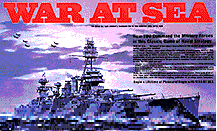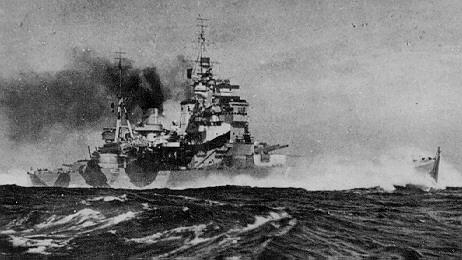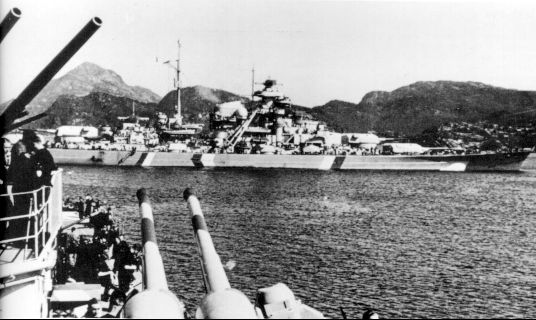

I hope you are all looking forward to the 2001 War at Sea tournament as much as I am! With the WBC at the end of June, it's only seven weeks away! I'm starting to get anxious already! See you soon! - John Pack
There will be four minor changes this year. Knowing that the tournament built by Alan Applebaum, Bruce Monnin, and Vince Meconi is already seen as near perfect by most of its participants (including me), I hope these small changes will either be unnoticeable or slightly improve your experience! Let me know what you think!
Of the four changes, the first might seen the most dramatic but will probably have the least impact! John Pack will be taking the role of GM for a single year while Vince Meconi is swamped in the Delaware legislative session. (Apparently high taxes aren't enough, they're taking our best GMs now too!)
Vince will return to the helm in 2002 when the WBC moves back to its normal time-slot. Vince will even be handling the post-tournament newsletter with all the statistics for this year's tournament. No one can churn out stats like Vince!
The tournament pairings and status board will be run exactly the way they have been for the past two years - using exactly the same equipment! With any luck, many of you won't even realize the GM is any different! In the meantime, if you have questions feel free to write me at john@gameaholics.com, 1216 East Tamara, Sandy, UT 84094 or call (801) 523-0571!
The next change is a minor schedule alteration. As many of you know, the teaching session for new players is no longer one hour prior to the tournament. My hope is that the new session in Café Jay (not so early in the morning) will attract more newcomers than ever!
|
|
|
|
|
|
|
|
|
|
|
|
|
|
|
|
|
|
|
|
|
|
|
|
While the established victory point system will still be used to determine the order of finish in the five prelim-inary Swiss rounds, a new tie-breaker will be used first to break ties. With the record-breaking number of participants, it has become more and more frequent that a player with 40 points has been eliminated by tie-breakers going into the Final Four (in fact, it has happened three times in the past two years).
To make the tie-breaking process as fair as possible (i.e., as linked as possible to a player's own results), a head-to-head tie-break will be used before the traditional strength of schedule tie-break.
In the following examples, Joe, Steve, Mark, and Larry all have 40 VPs and their strength of schedule tie-breaks are 6.1, 5.7, 5.6, and 3.9 respectively.
#1: Larry defeated Steve and Joe defeated Mark during the preliminaries. Joe and Larry both advance to the Final Four before Steve and Mark. Joe advances before Larry and Steve before Mark based on the strength of schedule.
#2: Joe has defeated Steve who, in turn, has defeated Mark in the prelims. Joe would advance to the Final Four first, followed by Steve. If there's still room, Mark advances before Larry based on the strength of schedule.
#3: Larry defeated Mark who defeated Steve who defeated Larry during the prelims. The strength of schedule tie-break is used - advancing Steve. The head-to-head tie-break is then reapplied to Larry and Mark - advancing Larry. If there's still room, Mark advances before Joe since Mark has a head-to-head win over Steve.
The biggest change will be the mandatory use of chess clocks in each game. Glenn Petroski successfully experimented with chess clocks in each of his last three Victory in the Pacific tournaments where the clocks have been enthusiastically received. Glenn has graciously consented to allow those same clocks to be used in our War at Sea!
With 3-4 games requiring lengthy adjudication at the end of each round, our tournament has traditionally fallen far behind schedule (by as much as 15-20 minutes per round) - making it harder for participants to play all five prelimi-nary rounds by running into the start times for many Thursday evening events. The chess clocks will allow our event to run on time and eliminate the need for subjective adjudication.
The rules which will govern the use of chess clocks are the following (with many thanks to Glenn Petroski):
Clock Setup: The Allied player's clock is set to 11:00 (one hour remaining). The Axis player's clock is set to 11:15 (45 minutes remaining). The other 15 minutes during each round will be used for announcements/admin tasks.
On Clock: The "on-clock" player is the player who's clock is running and is currently performing some game action. The "off-clock" player may not take game actions other than monitoring the "on-clock" player and, if agreeable to the "on-clock" player, helping with accounting functions (e.g., placing damage markers, removing sunk ships, etc.).
Running Clock: One player or the other is always "on-clock." Players may never set their clocks in the neutral position, not even by mutual consent or to ask the GM a question. Doing so may forfeit the game for both players. Only the GM or an Asst. GM may set a clock to neutral. A player is on-clock during all of his movement, attack resolution, dice rolling, and basing. Thus it is running all of the time for one player or the other. Placing flags and counting PoC are functions of the Axis player and occur on his time.
A player may take breaks at his own risk. When the on-clock player finishes his move, he is free to trigger the clock, even if his opponent is not present. The absent player then goes on-clock and will lose time while he remains absent.
The Allied player goes "on-clock" as soon as bidding is complete or when the GM announces, "Start your clocks" (at which point any remaining set up is performed on Allied time). Try to have games set up prior to the round!
Changing Moves: Once a player triggers the clock, thereby starting his opponent's, he can not change his move, even if the opponent hasn't done anything. Conversely, if a player has not started the opponent's clock, he is free to alter his current action. For example: If the Axis moves to the North Sea and then places his LBA (and has not triggered his clock), the Axis could still change the North Sea move.
Out of time: When a player runs out of time, he goes off-clock for the remainder of the game. This off-clock player may no longer move any pieces nor physically roll any dice and is limited to monitoring the game. Any die rolls required of this off-clock player are treated as 1's; any ships that are required to move are sunk instead.
When a player runs out of time, the player with time remaining goes on-clock for the remainder of the game. This on-clock player continues to play thru the normal sequence of phases, turns, and events until one of the following occurs:
Congratulations, once again, to our 2000 Champion - Pat Richardson. His "it-must-not-be-as-risky-as-it-looks, go-for-the-gusto" style has brought him close before and earned him notoriety far beyond the War at Sea tournament field! We all knew it was only a matter of time before he won it all. Congratulations, Pat!
Finishing in 2nd-6th place were Steve Packwood, Ed Menzel, Ron Dietz, Mike Knautz, and Dave Streamo. All won at least four games! Vince also won Top GM honors! Congratulations!
- See you in a few weeks! John
Rules: Second Edition rules will be used - supplemented by the official clarifications.
Requirements: Please bring your own copy of the game. If insufficient copies of the game are available, those bringing a copy will have priority. Badges will be checked.
Schedule: The first 5 rounds will be preliminary qualifying rounds and the last 2 will be single elimination rounds matching the top 4 finishers. Players may play any one round, any combination of rounds, or every round. They may drop out and reenter any round, as long as they are present for the start of that round. To keep the tournament flowing smoothly, players are asked to please notify the Gamemaster if they know they will not be playing in the next round.
Preliminary Rounds: The preliminary portion of the tournament will be conducted using a Swiss System. Pairings for each round will be determined by a seeding system. For the first round, defending champion Pat Richardson, should he enter, will automatically receive the #1 seed. All other players will be seeded by their AREA ratings as of June 15, 2001. No distinction will be made between active and inactive ratings. Any player without an AREA rating will be assigned a rating of 5000. The highest seeded player will be paired against the lowest, the second highest against the second lowest, etc.
In subsequent rounds, each player will be matched against a player with an identical or similar Victory Point (VP) score (see Scoring). For example, if after Round 2 there are 8 players tied with 20 VPs, these players will again be seeded using AREA ratings, and the highest seeded of these 8 players will be matched up with the lowest seeded, the 2nd highest seeded with the 2nd lowest seeded, etc. If there are only 7 players with the same VP total, then the next highest scoring player will be added to that group and the pairings will be made. Pairings then continue with the next highest scoring set of players, etc. until all players are matched. The only exception to the seedings will be that two players will never play each other twice during the 5 preliminary rounds.
All players will have their own cards detailing their progress in the tournament. These cards will have a magnetic backing so that they can be stuck to a sheet metal standings board. After each round, players' cards will be adjusted to reflect their current positions in the standings and to make clear whom they may be paired against in the next round.
Scoring: Each game in the preliminary rounds is worth 10 Victory Points (VPs). If the game is decided by 2 or more PoC, the winner gets all 10 VP and the loser gets 0 VP. If the game is won by 1 PoC, the winner gets 8 VP and the loser 2 VP. Each player gets 5 VP for a draw. In each case, VPs are awarded after any bid is applied.
Byes: If there is an odd number of players available for a round, one player will receive a bye and get credit for a win (10 VP). The lowest-seeded player among the players tied for the lowest VP score will receive the bye. No player will receive more than one bye during the tournament. If any of you are not competing this year, please feel free to stop by during a break to help us avoid byes.
Sides: Players simultaneously reveal which side they wish to play, by using the Axis and Allied control flags provided in the game. If opposite sides are chosen, play proceeds. If both want the same side, the players bid for the right to play that side. Players determine who has the first option via a die roll. The player winning the roll may either accept the non-preferred side or bid a PoC-incentive to play the preferred side. The bid may be full or half-PoC amounts, including zero. If the first player bids to play the preferred side, the second player may either accept the PoC-incentive to play the non-preferred side or bid a higher PoC amount for the preferred side. The option passes back and forth in this fashion until one player accepts the non-preferred side and the PoC-incentive. The incentive is applied to the final score of the game.
Qualification for Final Four: The qualifiers for the semifinals will be the players with the top four VP totals from the preliminaries. Ties will be broken based on head-to-head results (the results of games between tied players; see examples on Page One); strength of schedule (# of VPs earned by one's opponents divided by the # of games played by one's opponents); and highest AREA rating.
Semifinals and Final: The semifinals and final will be single elimination; the winners of the two semifinal games will play each other in the final for the championship. Pairings for the semifinals will be determined by performance in the preliminaries; the #1 ranked player will play the #4 player and the #2 player will play the #3 player unless such pairings would result in a rematch. Bidding for sides in the semifinals and the final will be handled as in the preliminaries. If any of these games end in a tie, the following tie-breakers will be used, in this order: 1) disregard any bid, 2) highest score in the preliminary rounds, 3) any prior head-to-head result, 4) strength of schedule (including semifinal), and 5) highest rating.
Dice: It is customary (though not required) to roll all dice in a box lid; dice landing outside the box are rerolled. Other methods such as dice towers are fine as long as they are mutually agreed upon.
Spectators: Spectators are welcome to observe the matches in progress. However, spectators are not permitted to participate in any way. Spectators may not point out the legality or illegality of any move, nor be consulted on rules clarifications. Such inquiries should go to the GM or an assistant GM.
Conduct: Abusive behavior and language are not permitted. However, it wouldn't be War At Sea without a lot of whining about poor die rolls.
AREA: The results of all games will be reported to Glenn Petroksi for inclusion in the AREA rating system.
|
|
|
|
|
|
|
|
|
|
|
|
|
|
|
|
|
|
|
|
|
|
|
|
|
|
|
|
|
|
|
|
|
|
|
|
|
|
|
|
|
|
|
|
|
|
|
|
|
|
|
|
|
|
|
|
|
|
|
|
|
|
|
|
|
|
The indefatigable Bruce Monnin has published the The Boardgamer's Unofficial Guide to War At Sea. A wealth of information, it and The Boardgamer are available from Bruce for $7 at monninb@bright.net or 177 South Lincoln Street, Minster, OH 45865-1240. The Boardgamer is published quarterly and focuses on the WBC, its Century titles, and AREA ratings!
John Pack prepared a single sheet summary of the WAS rules and hints on strategy and tactics. It is reproduced at WaS Strategy Tips for your enjoyment.
 |
VitP at Gameaholics.com, <http://www.gameaholics.com/vitp_tournament.htm>, the website for Victory in the Pacific!
A site with AREA ratings for every player in every game is maintained by
Bruno Wolff III at:
<www.uwm.edu/people/bruno/AREA>.
The Boardgame Players Association, which has all the latest information about the World Boardgaming Championships, is at: <http://www.boardgamers.org>.
Another good site is ConsimWorld, "the official news, information, and talk site covering the historical boardgaming industry," which includes discussions on a wide variety of gaming topics, including Avalon Hill, product releases from a number of companies, and specific games like War At Sea. The URL is: <www.consimworld.com>.
Finally, Web-Grognards advertises itself as "the site for wargames on the web." Check them out at: <www.grognard.com>.
 |
